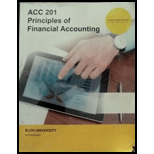
(a)
To calculate:
No. of shares when notes are converted into shares of stock
Introduction:
Convertible Subordinate Notes are short term debts that are not paid unless the senior debtholders have been paid. Hence, it is the subordinate of the senior debt. Moreover, debtholders can exchange the subordinate notes with the shares of common stock.
(b)
Whether Senior Notes would be redeemable at discount, premium or at par.
Introduction:
Notes can be redeemable i.e. can be redeemed before its maturity date and are like callable bonds. Redeemable callable bonds can be paid off by the issuer before the maturity, so it has higher annual
(c)
The meaning of the statement that backup credit facility with a consortium of banks up to $800 million has been granted to the firm. It contains various restrictive covenants, none of which is expected to materially impact the company's resources or liquidity.
Introduction:
Backup credit facility is a credit line for commercial papers. Commercial Papers are issued by creditworthy companies only. Banks promises to pay off the invested amount if the company defaults on its promise.
(d)
Information required for "Capital Lease Obligation" while assessing the overall liquidity and leverage.
Introduction:
Capital Lease Obligation is a long-term obligation which arises when land is taken on lease by the lessee. Lessee is the tenant of the property whereas lessor is the owner.
Liquidity is the ability of the firm to pay off its short-term obligations using current assets.
Leverage is using the debt to raise the potential return made in various investments.
(e)
The meaning of "Interest Imputed at rates between 5.2% and 10%".
Introduction:
Interest in imputed when the agreed rate of interest on loan or note differs from the market interest rate. In such a case, imputed interest is considered so that note represent the present value of the consideration paid.
(f)
Unsecured Bank Loan is immaterial to the total assets of the firm.
Introduction:
Immaterial is something that have no or very less value to affect the financial statement of the firm. Immaterial also means something that is not constant in the financial statement and occurs unusually.
(g)
Why Current installments on the long-term debt is immaterial?
Introduction:
Immaterial is something that have no or very less value to affect the financial statement of the firm. Immaterial also means something that is not constant in the financial statement and occurs unusually.
Want to see the full answer?
Check out a sample textbook solution
Chapter 7 Solutions
Principles of Financial Accounting (Elon University)
- I need guidance in solving this financial accounting problem using standard procedures.arrow_forwardSuperior Manufacturing uses a predetermined overhead rate based on direct labor hours to allocate manufacturing overhead to production jobs. For 2024, the company's budget includes estimated manufacturing overhead of $720,000 and estimated direct labor hours of 20,000. In March, the production department completed Job #304, which required $8,200 in direct materials and $4,500 in direct labor (representing 250 hours at $18 per hour). The cost accountant needs to determine the predetermined overhead rate, the manufacturing overhead allocated to Job #304, and the total cost of this job.arrow_forwardPlease provide the answer to this general accounting question with proper steps.arrow_forward
- Can you solve this general accounting problem with appropriate steps and explanations?arrow_forwardScarlett Manufacturing uses the number of machine hours to allocate overhead costs to products. In a typical month, 8,400 machine hours are expected, and the average monthly overhead costs are $7,560. During March, 8,100 machine hours were used, and total overhead costs were $7,290. Required: Compute Scarlett's predetermined overhead rate and the amount of applied overhead for March. Round your answers to the nearest cent.arrow_forwardI need assistance with this financial accounting problem using valid financial procedures.arrow_forward

 AccountingAccountingISBN:9781337272094Author:WARREN, Carl S., Reeve, James M., Duchac, Jonathan E.Publisher:Cengage Learning,
AccountingAccountingISBN:9781337272094Author:WARREN, Carl S., Reeve, James M., Duchac, Jonathan E.Publisher:Cengage Learning, Accounting Information SystemsAccountingISBN:9781337619202Author:Hall, James A.Publisher:Cengage Learning,
Accounting Information SystemsAccountingISBN:9781337619202Author:Hall, James A.Publisher:Cengage Learning, Horngren's Cost Accounting: A Managerial Emphasis...AccountingISBN:9780134475585Author:Srikant M. Datar, Madhav V. RajanPublisher:PEARSON
Horngren's Cost Accounting: A Managerial Emphasis...AccountingISBN:9780134475585Author:Srikant M. Datar, Madhav V. RajanPublisher:PEARSON Intermediate AccountingAccountingISBN:9781259722660Author:J. David Spiceland, Mark W. Nelson, Wayne M ThomasPublisher:McGraw-Hill Education
Intermediate AccountingAccountingISBN:9781259722660Author:J. David Spiceland, Mark W. Nelson, Wayne M ThomasPublisher:McGraw-Hill Education Financial and Managerial AccountingAccountingISBN:9781259726705Author:John J Wild, Ken W. Shaw, Barbara Chiappetta Fundamental Accounting PrinciplesPublisher:McGraw-Hill Education
Financial and Managerial AccountingAccountingISBN:9781259726705Author:John J Wild, Ken W. Shaw, Barbara Chiappetta Fundamental Accounting PrinciplesPublisher:McGraw-Hill Education





